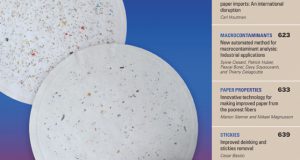The papers summarized here are from the August 2016 and September 2016 issues of TAPPI Journal. TAPPI Journal is an online publication of relevant and timely peer-reviewed research delivered via email and free to all TAPPI members. To receive TAPPI Journal, join TAPPI at www.tappi.org.
AUGUST
FIBER SUPPLY
Examination of the potential to reduce water application rates for hardwood pulp logs stored in wet decks
Heath Raybon, Laurence Schimleck, Kim Love, Finto Antony, Joe Sanders, Richard Daniels, Edward Andrews, and Erik Schilling
Study log (highlighted) positioning in Offerman experimental wet deck.
Wet storage of logs under sprinklers is often used to maintain log quality and to provide consistent fiber supply to wood production facilities. Concerns about water use in the southeastern United States have increased interest in refining water application strategies in woodyards. By understanding how the moisture content of stored logs varies over time in response to varying rates of water application, an optimum moisture regime for stored logs could be identified.
In this study, experimental trials with nominal water application (100 mm/day) and a 30 percent reduction in water application were established at two hardwood woodyards in Georgia (Offerman, with sweetgum and yellow poplar,  and McBean, with red oak and sweetgum). Significant differences between treatments were observed initially (likely resulting from pre-existing differences in the wood), but differences in log moisture soon disappeared. Pulping trials conducted using McBean woodyard logs stored for 9, 12, and 15 months found that treatment had no effect on pulp yield, indicating that a 30 percent reduction in the amount of water applied results in little change in log quality.
and McBean, with red oak and sweetgum). Significant differences between treatments were observed initially (likely resulting from pre-existing differences in the wood), but differences in log moisture soon disappeared. Pulping trials conducted using McBean woodyard logs stored for 9, 12, and 15 months found that treatment had no effect on pulp yield, indicating that a 30 percent reduction in the amount of water applied results in little change in log quality.
PAPERMAKING
Alkyl ketene dimer (AKD) sizing of paper under simplified treatment conditions
Ahsen Ezel Bildik, Martin A. Hubbe, and K. Bahattin Gürboy
Contact angle tests quantified the effects of AKD in increasing water resistance of treated papers.
Alkyl ketene dimer (AKD) has been widely used by manufacturers of paper and paperboard as a hydrophobic sizing agent. Ordinary sizing with AKD involves a complex series of processes, including emulsification of the waxy AKD material; measures to avoid the agglomeration of the emulsified AKD particles; addition of a stabilized AKD dispersion to papermaking furnish; interactions with various retention aid chemicals to fix the material onto solid surfaces; and various spreading and curing processes that take place during the drying and cooling of the paper product.
 In this study, as a means to gain insight into the mechanisms attributable only to the AKD in isolation from the other additives and subprocesses, the AKD wax was dissolved in heptane and applied to filter paper between two aluminum foil layers, followed by evaporation of the solvent and optional heating. Surprisingly, the hydrophobic character was obtained regardless of whether or not the treated sheets had been heat cured. Also, for the first time, it was observed that the AKD treatment resulted in a substantial increase in sheet strength, suggesting that the AKD was able to serve as the matrix in an AKD-saturated paper structure. The results add support to past suggestions in research literature that potential covalent interactions cannot account for all of the effects attributable to AKD treatment of paper.
In this study, as a means to gain insight into the mechanisms attributable only to the AKD in isolation from the other additives and subprocesses, the AKD wax was dissolved in heptane and applied to filter paper between two aluminum foil layers, followed by evaporation of the solvent and optional heating. Surprisingly, the hydrophobic character was obtained regardless of whether or not the treated sheets had been heat cured. Also, for the first time, it was observed that the AKD treatment resulted in a substantial increase in sheet strength, suggesting that the AKD was able to serve as the matrix in an AKD-saturated paper structure. The results add support to past suggestions in research literature that potential covalent interactions cannot account for all of the effects attributable to AKD treatment of paper.
Results of simplified tests, as in this study, can reveal some aspects of AKD interactions beyond what can be noticed from tests carried out under conventional papermaking conditions.
COATING
Functional surfaces produced by foam coating
Eija Kenttä, Hanna Koskela, Sara Paunonen, Karita Kinnunen-Raudaskoski, and Tuomo Kjelt
High-resolution SEM-secondary electron images of the base paper and the silica foam-coated paper surfaces.
This study reports experiments on silica coating formulations that are suitable for application as a thin pigment layer with foam coating technique on a paper web. To understand the foaming properties of nanosilica dispersions, the critical micelle concentration, foam half-life time, and foam bubble size stability were determined with three different foaming agents. The results indicate that the bubble stability measurement is a useful characterization method for foam coating purposes. Pilot foam coating trials were done and the effects of the chosen foaming agents were studied on the properties of the nanosilica-coated paper. The surface hydrophilicity of silica coated paper was related not only to silica pigment, but also to the chemical nature of the foaming agent. Standard paper properties were not affected by the thin silica coating.
Foam half-life time and bubble size growth determination are useful tools when creating stable foam for foam coating. Mills can adjust properties of foam coated surfaces through selection of the coating compound and the properties of the foaming agent.
RECYCLING
Deinking evaluation using near infrared narrow band digital image analysis
Roland Gong, Paul D. Fleming, John Cameron, and Jan Pekarovic
Top four images of office paper from scanner and NIR camera had clear, dark ink specks, while bottom newsprint images were not as defined.
Current deinking evaluation methods include visual image analysis (manual and digital) and optical reflectance (using the Kubelka-Munk equation). The mechanism of image analysis is simple: dark ink (mostly black) is isolated from the light background (fiber) and then captured visually or by digital devices. The image analysis methods have inherent limits and large variances from sample to sample and side to side.
In this study, researchers applied an innovative approach that employs a band of near infrared (NIR) light and a digital imaging device. This approach has advantages for isolating specks from backgrounds, obtaining high quality raw data, and significantly reducing the variances among the handsheets and their sides. By using the ink elimination equation derived from image analysis, reliable ink elimination rates were obtained that were well-correlated with paper optical properties. This system was also applied to newspaper deinking evaluation with positive results.
The research indicated that NIR image analysis technology can be developed into an online instrument for instantly analyzing high-consistency pulp.
SEPTEMBER
FIBER SUPPLY
Effects of localized environment on eucalyptus clone chemical composition
Flávia Natalino Oliveira, Jorge Luiz Colodette, Fernando Palha Leite, and Fernando José Borges Gomes
 Eucalyptus wood is becoming the most important feedstock for bleached kraft pulp production, particularly in South America. However, pulp manufacturers have observed that some eucalyptus clones are resistant to wind action and others are not. Those lacking wind resistance are prone to breaking, which results in productivity losses.
Eucalyptus wood is becoming the most important feedstock for bleached kraft pulp production, particularly in South America. However, pulp manufacturers have observed that some eucalyptus clones are resistant to wind action and others are not. Those lacking wind resistance are prone to breaking, which results in productivity losses.
This study investigated a correlation between the chemical composition of eucalyptus clones and their resistance to wind action. The researchers found differences among the wind-resistant and non-wind-resistant clones, but that the fragility of trees studied for wind resistance does not correlate to the chemical composition of the wood. Researchers observed four notable differences. First, clones grown at lower altitudes differed from clones grown at higher altitudes in their acetyl, insoluble lignin, and extractives contents, and in their syringyl/guaiacyl (S/G) ratios; however, the researchers found no relationship among these components and wind susceptibility. Second, soluble lignin content increased with the increase of wind resistance in the high altitude clones. Third, the low altitude clones showed slightly lower xylan content (12.4 percent) and higher lignin content (29.6 percent) than the others. Finally, the insoluble lignin content, total acetyl groups, extractives, ash contents, and S/G ratios of the clones were influenced by the region where they were grown.
The results of this study provide important information for helping pulp mills increase wood productivity and decrease pulp production costs.
BLEACHING
Bleaching optimization at WestRock mill in Covington, Virginia
Ricardo B. Santos, Peter W. Hart, Douglas C. Pryke, and John Vanderheide
The WestRock mill in Covington, VA, initiated a long-term diagnostic and optimization program for all three of its bleaching lines. Benchmarking studies were used to help identify optimization opportunities. Capital expenditures for mixing improvement, filtrate changes, equipment repair, other equipment changes, and species changes were outside the scope of this work. This focus of this paper is the B line, producing southern hardwood pulp
 in a D(EP)DD sequence at 88 percent GE brightness. The benchmarking study and optimization work identified the several opportunities for improved performance. As a result of actions the mill undertook to address these opportunities, D0 kappa factor decreased about 5 percent, sodium hydroxide consumption in the (EP) stage decreased about 35%, chlorine dioxide consumption in the D1 stage decreased about 25 percent, and overall bleaching cost decreased about 15 percent.
in a D(EP)DD sequence at 88 percent GE brightness. The benchmarking study and optimization work identified the several opportunities for improved performance. As a result of actions the mill undertook to address these opportunities, D0 kappa factor decreased about 5 percent, sodium hydroxide consumption in the (EP) stage decreased about 35%, chlorine dioxide consumption in the D1 stage decreased about 25 percent, and overall bleaching cost decreased about 15 percent.
This long term, sustainable, bleach plant optimization and cost reduction study was performed with minimal to no capital. Mills can apply similar methodologies to their own bleach plants and obtain reasonable results.
RECOVERY CYCLE
Acoustic analysis of recovery boiler dissolving tank operation and smelt shattering efficiency
Hugo Lepage, Willy Wong, Markus Bussmann, and Honghi Tran
Schematic of setups used during the mill recordings.
The interaction of molten smelt and water inside a recovery boiler dissolving tank produces loud noise and can be violent even during normal boiler operation. Inadequate shattering of the smelt stream leads to even more violent interaction, as evidenced by an increased acoustic intensity of the dissolving tank. On rare occasions, a violent dissolving tank can explode, causing equipment damage and even injury to personnel.
To assess the feasibility of an acoustics-based monitoring system to warn operators of changing conditions, researchers recorded acoustic observations at three pulp mills. Analysis of the recordings indicates that when a smelt stream is not being shattered, the intensity of the dissolving tank soundscape increases significantly and the frequency spectrum changes. The researchers also observed a large variation between different mills both in average intensity and in signal variance.
The results of this study suggest that the development of a monitoring system is feasible. If an acoustics-based automated monitoring system is successfully developed to track the dissolving tank activity in real-time and warn boiler operators of changing conditions, it can help pulp mills significantly improve their recovery boiler operation and safety.
OTHER RESEARCH
APPEARING IN
TAPPI Journal’s
august 2016 ISSUE:
RECOVERY CYCLE
Effects of silica on chemical recovery in the direct causticization of wheat straw black liquor
Hongyou Yuan, Shubin Wu, Xiuli Yin, Daliang Guo, Guijin Wang, Zhaoqiu Zhou, and Chuangzhi Wu
OTHER RESEARCH
APPEARING IN
TAPPI Journal’s
SEPTEMBER 2016 ISSUE:
 Paper 360
Paper 360


